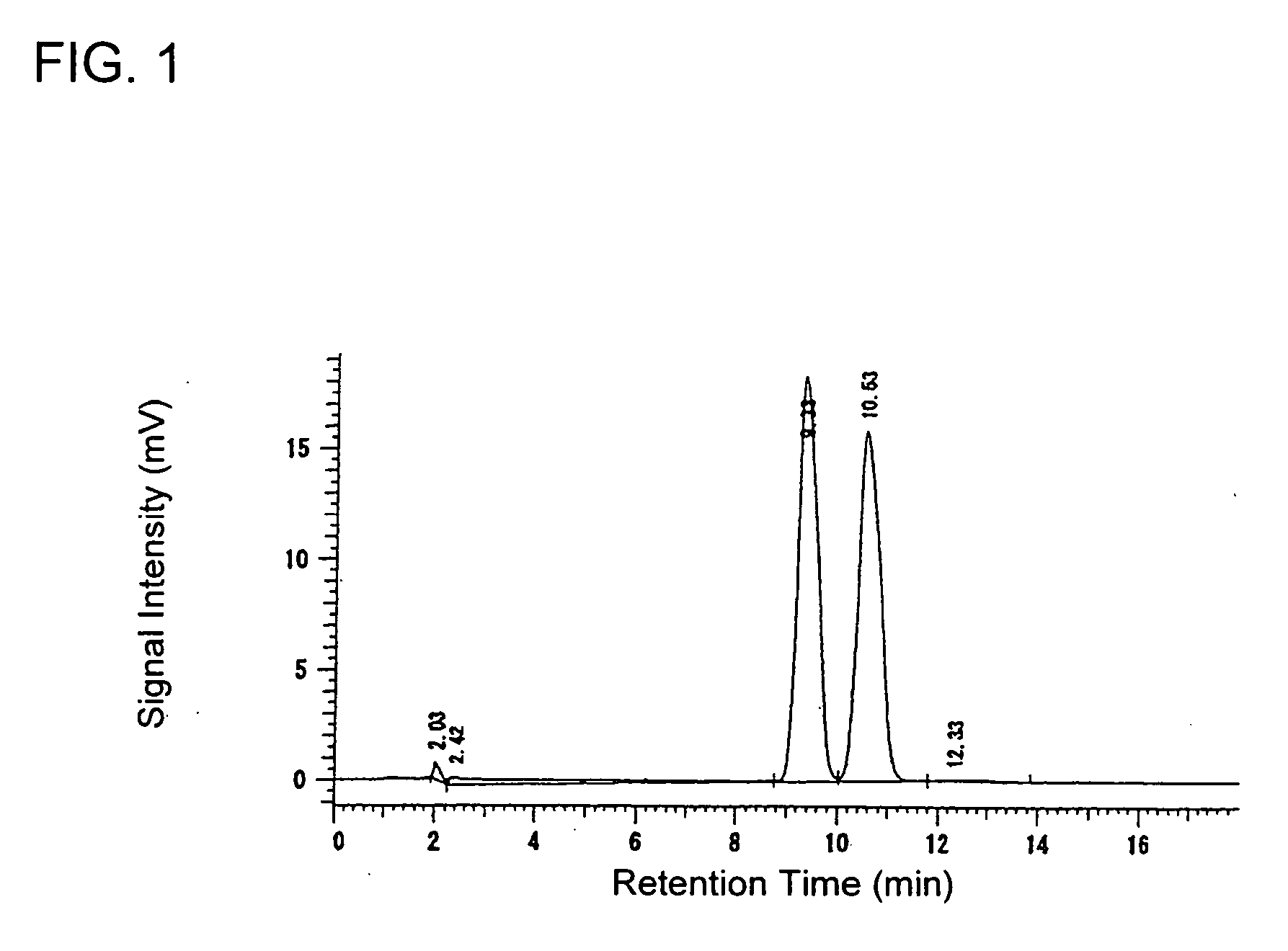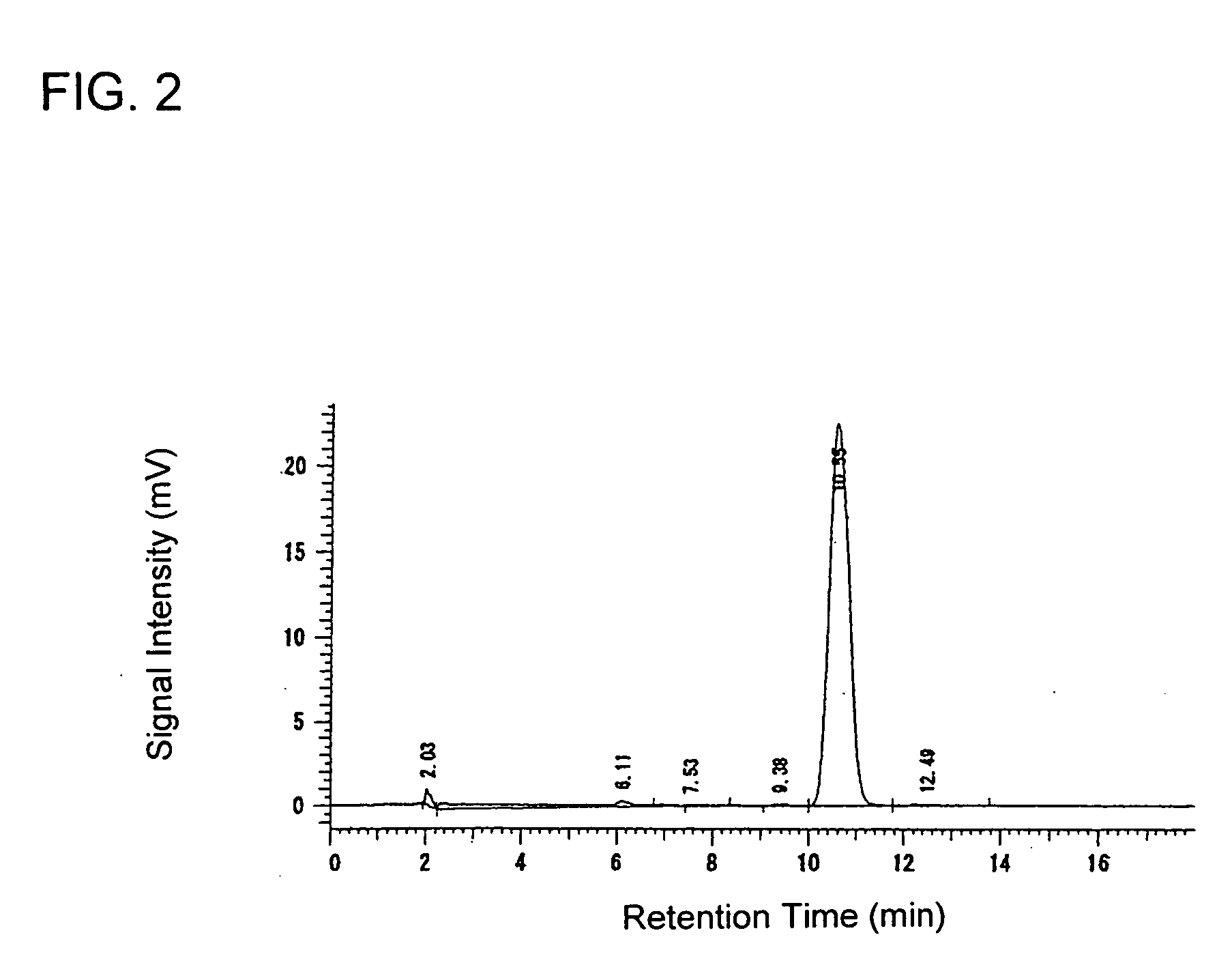3-Hydroxy-3-(2-thienyl) propionamides and production method thereof, and production method of 3-amino-1-(2-thienyl)-1-propanols using the same
a technology of 3-amino-1-(2-thienyl)propanol and production method, which is applied in the direction of organic-compound/hydride/coordination-complex catalyst, physical/chemical process catalyst, biocide, etc., can solve the problems of insufficient optical yield, waste half of substrate, and low optical yield of about 85%, and achieve the effect of easy production
- Summary
- Abstract
- Description
- Claims
- Application Information
AI Technical Summary
Benefits of technology
Problems solved by technology
Method used
Image
Examples
production example 1
Synthesis of 3-oxo-3-(2-thienyl)propionic Acid Ethyl Ester
[0223] A 10.16 g portion of 60% sodium hydride and 78 g of diethyl carbonate were charged using 60 ml of tetrahydrofuran at 24° C. and then the temperature was increased to carry out reflux. At said temperature (79° C.) a solution prepared by dissolving 20 g of 2-acetylthiophene in 20 ml of tetrahydrofuran was added dropwise thereto spending 50 minutes. Thereafter, the mixture was stirred at said temperature for 1 hour and then ice-cooled when the reaction was completed. When the reaction solution was analyzed by a liquid chromatography, the reaction yield was 94%.
[0224] A 63 ml portion of 4 N hydrochloric acid aqueous solution was ice-cooled in advance, and the ice-cooled reaction solution was added dropwise thereto in such a manner that the solution temperature was kept at about 10° C. The pH value after the dropwise addition was 6. Next, separation of layers was carried out, and the water layer was further extracted thre...
production example 2
Synthesis of 3-oxo-(2-thienyl)propionic Acid Ethyl Ester
[0230] A 13.31 g portion of 60% sodium hydride and 56.1 g of diethyl carbonate were charged using 105 ml of tetrahydrofuran at 24° C. and then the temperature was increased to 60° C. At said temperature, a solution prepared by dissolving 30 g of 2-acetylthiophene in 15 ml of tetrahydrofuran was added dropwise thereto spending 20 minutes. Thereafter, the mixture was stirred at said temperature for 1 hour and then ice-cooled when the reaction was completed. When the reaction solution was analyzed by a liquid chromatography under the same conditions of the aforementioned Production Example 1, the reaction yield was 99%.
[0231] A 87.4 ml portion of 4 N hydrochloric acid aqueous solution was ice-cooled in advance, and the ice-cooled reaction solution was added dropwise thereto in such a manner that the solution temperature was kept at about 10° C. Since the pH value after the dropwise addition was 1.5, the pH was adjusted to 7 with...
production example 3
Synthesis of 3-oxo-3-(2-thienyl)propionic Acid Ethyl Ester
[0232] A 0.254 g portion of 60% sodium hydride and 1.95 g of diethyl carbonate were charged using 1.0 ml of tetrahydrofuran at 24° C. and then the temperature was increased to carry out reflux. At said temperature (79° C.) a solution prepared by dissolving 0.5 g of 2-acetylthiophene in 1 ml of tetrahydrofuran was added dropwise thereto spending 15 minutes. Thereafter, the mixture was stirred at said temperature for 1 hour, and when the reaction was completed, the reaction solution was analyzed by a liquid chromatography under the same conditions of the aforementioned Production Example 1 to find that the reaction yield was 89%.
PUM
| Property | Measurement | Unit |
|---|---|---|
| Fraction | aaaaa | aaaaa |
| Fraction | aaaaa | aaaaa |
| Solubility (mass) | aaaaa | aaaaa |
Abstract
Description
Claims
Application Information
 Login to View More
Login to View More - R&D
- Intellectual Property
- Life Sciences
- Materials
- Tech Scout
- Unparalleled Data Quality
- Higher Quality Content
- 60% Fewer Hallucinations
Browse by: Latest US Patents, China's latest patents, Technical Efficacy Thesaurus, Application Domain, Technology Topic, Popular Technical Reports.
© 2025 PatSnap. All rights reserved.Legal|Privacy policy|Modern Slavery Act Transparency Statement|Sitemap|About US| Contact US: help@patsnap.com



